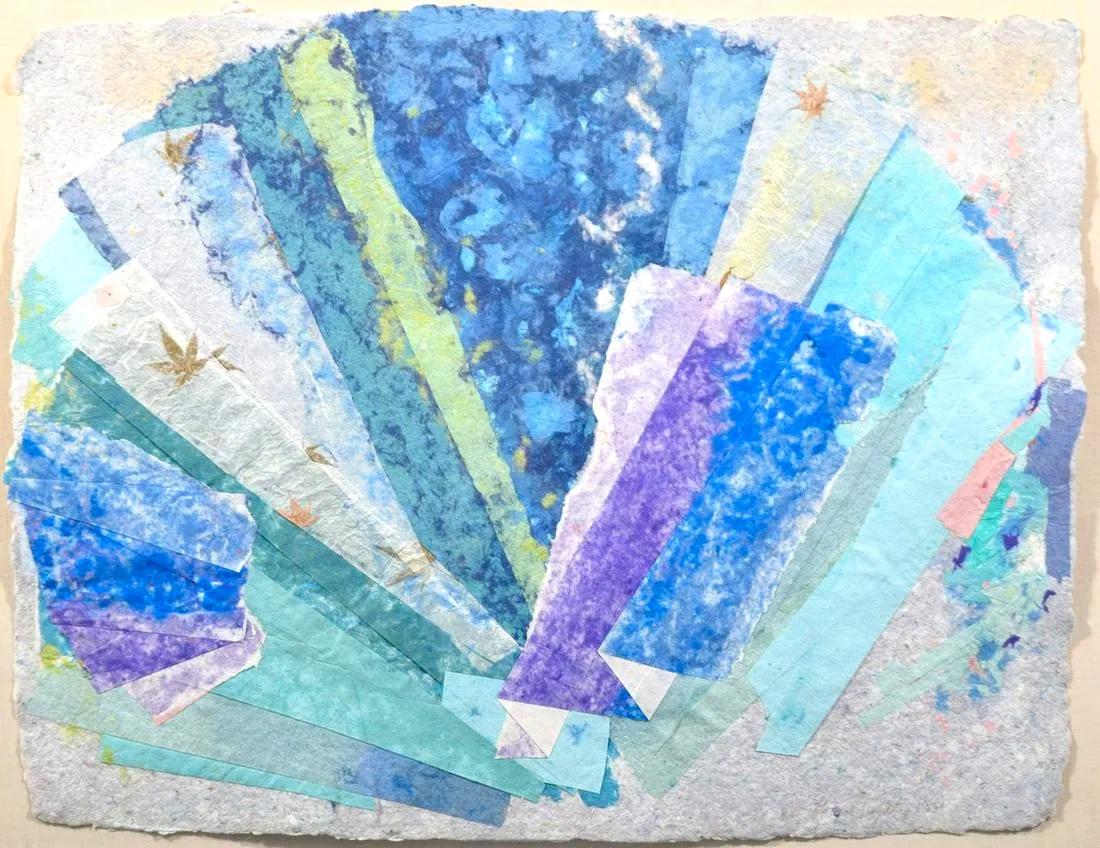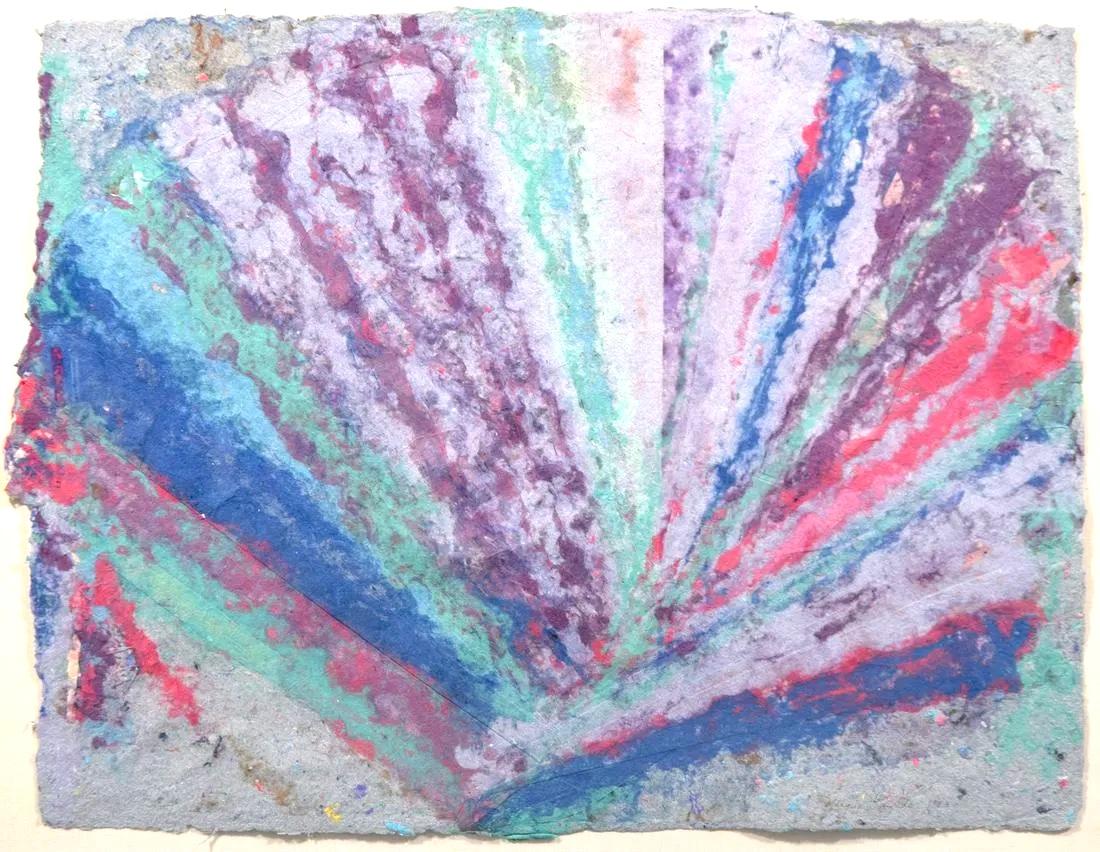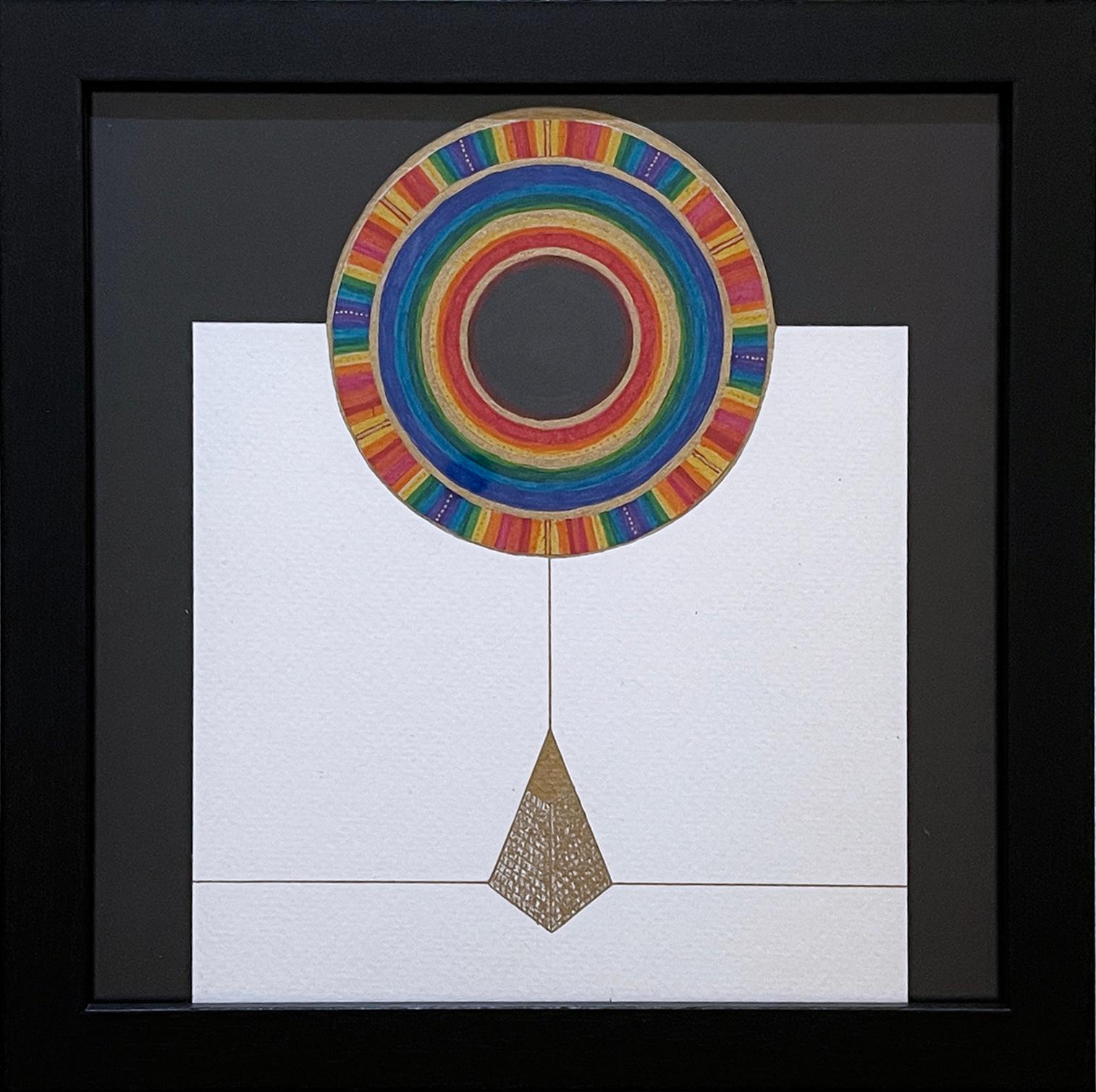Items Similar to Color Circle and Star
Want more images or videos?
Request additional images or videos from the seller
1 of 4
Polly ApfelbaumColor Circle and Star2004
2004
About the Item
Polly Apfelbaum
Color Circle and Star, 2004
Fabric Marker and Fabric Dye on Velvet Cotton
Signed and dated in ink by the artist on the front with artist's inkstamp.
Frame Included
Signed, numbered and dated from the limited edition of only 20, and dated in ink on front with artist's ink stamp. This work ships framed.
Not the first to tackle the color wheel, Apfelbaum's minimalistic aesthetic and influences from postwar abstraction are exemplified in this simple geometric design. Apfelbaum adds a handmade quality by saturating the colors through the cotton and allowing them to bleed outside of the lines of the print.
Measurements:
Frame:
31 x 31 x 1 inches
Artwork:
29 x 29 inches
ABOUT POLLY APFELBAUM
Known for her palette of eye-popping colors and hues, Polly Apfelbaum creates what she calls "fallen paintings," works which exist in a space between painting, sculpture, and installation. After using preliminary sketches and maps to plan the paintings, the designs are then arranged on the floor using hand-dye fabrics in vibrant, saturated colors. Organically inspired, her works channel both abstract painting with their geometric form and also non-representational subject matter, but maintain a physical and sculptural presence in the space within which they are contained.
Considered one of the of the most original artists working today, Apfelbaum's paintings push past the traditional disciplinary forms and into pop culture, while forcing the viewer to revel in the pure aesthetic joy of the finished creation. A graduate of Tyler School of Art, Apfelbaum has had solo exhibitions at Kiasma, Museum of Contemporary Art NYKY; Helsinki, Finland; and Bowdoin College Museum of Art, Brunswick, Maine.
- Creator:Polly Apfelbaum (1955, American)
- Creation Year:2004
- Dimensions:Height: 31 in (78.74 cm)Width: 31 in (78.74 cm)Depth: 1 in (2.54 cm)
- Medium:
- Movement & Style:
- Period:
- Condition:the fabric has been pressed but has natural waves and imperfections and unevenness, as well as color bleed which is all part of the design and creative process and not a condition issue.
- Gallery Location:New York, NY
- Reference Number:1stDibs: LU1745212605212
About the Seller
5.0
Platinum Seller
These expertly vetted sellers are 1stDibs' most experienced sellers and are rated highest by our customers.
Established in 2007
1stDibs seller since 2022
289 sales on 1stDibs
Typical response time: 1 hour
- ShippingRetrieving quote...Ships From: New York, NY
- Return PolicyA return for this item may be initiated within 1 day of delivery.
More From This SellerView All
- Blue Blossom unique signed work on handmade hand dyed paper ex Tupperware Coll.Located in New York, NYMargie Hughto Blue Blossom, 1983 Dyed Handmade paper Hand signed and dated by the artist on the lower right front. Titled on the back. Frame Included in ...Category
1980s Abstract Abstract Drawings and Watercolors
MaterialsDye, Handmade Paper, Mixed Media, Permanent Marker
- Orchid & Red, unique signed work on handmade hand dyed paper ex Tupperware Coll.Located in New York, NYMargie Hughto Orchid & Red, 1983 Dyed Handmade paper Hand signed and dated by the artist on the lower right front. Titled on the back. Unique Frame Inclu...Category
1980s Abstract Expressionist Abstract Drawings and Watercolors
MaterialsDye, Handmade Paper, Mixed Media, Permanent Marker
- "This is for Nadine": hand signed unique marker drawing in exhibition catalogueBy James SienaLocated in New York, NYJames Siena "This is for Nadine", signed drawing, 2005 Original drawing done in black marker, bound in the title page of softcover PACE Gallery catalogue with stiff wraps hand signe...Category
Early 2000s Abstract Geometric Abstract Drawings and Watercolors
MaterialsPaper, Ink, Mixed Media, Lithograph, Offset, Felt Pen
- Grass Power, original unique signed drawing, hand signed and inscribed; FramedBy Mark di SuveroLocated in New York, NYMark di Suvero Grass Power, 1979-2014 Mixed Media drawing: marker, ink and pencil on paper Hand titled, signed and inscribed to Nadine by Mark di Suvero Frame included: Floated and f...Category
2010s Abstract Expressionist Abstract Drawings and Watercolors
MaterialsPaper, Ink, Permanent Marker, Pencil, Mixed Media
- Yayoi's Guitar unique signed work on paper by internationally renowned sculptorBy Mark di SuveroLocated in New York, NYMark di Suvero Yayoi's Guitar, 1980 Ink wash drawing Signed and titled in red ink on the front Frame included (held in original vintage frame) Unique 1980 drawing by sculptor Mark di...Category
1980s Abstract Expressionist Abstract Drawings and Watercolors
MaterialsInk, Watercolor, Permanent Marker, Mixed Media
- Unique drawing Geometric Abstraction on postcard conceptual art (hand signed)By Sol LeWittLocated in New York, NYSol LeWitt Unique Geometric Abstraction on Postcard, 1982 Original drawing done on postcard from the Van Gogh Museum (Amsterdam), mailed, stamped and postmarked (franked) from Spolet...Category
1980s Abstract Geometric Abstract Drawings and Watercolors
MaterialsInk, Postcard, Mixed Media, Offset
You May Also Like
- 1950s Abstract Composition in Brown, Orange and Blue with Black Parallel LinesBy Herbert BayerLocated in Denver, COWatercolor and ink on paper of an abstract composition of brown, orange and blue shapes between black parallel lines throughout the the piece by Herbert Bayer (1900-1985). Presented in a custom black frame with all archival materials. Framed dimensions measure 17 ⅞ x 22 ⅝ x 1 inches. Image size is 10 ¼ x 15 ½ inches. Painting is clean and in very good condition - please contact us for a detailed condition report. Expedited and international shipping is available - please contact us for a quote. About the Artist: Herbert Bayer enjoyed a versatile sixty-year career spanning Europe and America that included abstract and surrealist painting, sculpture, environmental art, industrial design, architecture, murals, graphic design, lithography, photography and tapestry. He was one of the few “total artists” of the twentieth century, producing works that “expressed the needs of an industrial age as well as mirroring the advanced tendencies of the avant-garde.” One of four children of a tax revenue officer growing up in a village in the Austrian Salzkammergut Lake region, Bayer developed a love of nature and a life-long attachment to the mountains. A devotee of the Vienna Secession and the Vienna Workshops (Wiener Werkstätte) whose style influenced Bauhaus craftsmen in the 1920s, his dream of studying at the Academy of Art in Vienna was dashed at age seventeen by his father’s premature death. In 1919 Bayer began an apprenticeship with architect and designer, Georg Schmidthamer, where he produced his first typographic works. Later that same year he moved to Darmstadt, Germany, to work at the Mathildenhöhe Artists’ Colony with architect Emanuel Josef Margold of the Viennese School. As his working apprentice, Bayer first learned about the design of packages – something entirely new at the time – as well as the design of interiors and graphics of a decorative expressionist style, all of which later figured in his professional career. While at Darmstadt, he came across Wassily Kandinsky’s book, Concerning the Spiritual in Art, and learned of the new art school, the Weimar Bauhaus, in which he enrolled in 1921. He initially attended Johannes Itten’s preliminary course, followed by Wassily Kandinsky’s workshop on mural painting. Bayer later recalled, “The early years at the Bauhaus in Weimar became the formative experience of my subsequent work.” Following graduation in 1925, he was appointed head of the newly-created workshop for print and advertising at the Dessau Bauhaus that also produced the school’s own print works. During this time he designed the “Universal” typeface emphasizing legibility by removing the ornaments from letterforms (serifs). Three years later he left the Bauhaus to focus more on his own artwork, moving to Berlin where he worked as a graphic designer in advertising and as an artistic director of the Dorland Studio advertising agency. (Forty years later he designed a vast traveling exhibition, catalog and poster -- 50 Jahre Bauhaus -- shown in Germany, South America, Japan, Canada and the United States.) In pre-World War II Berlin he also pursued the design of exhibitions, painting, photography and photomontage, and was art director of Vogue magazine in Paris. On account of his previous association with the Bauhaus, the German Nazis removed his paintings from German museums and included him among the artists in a large exhibition entitled Degenerate Art (Entartete Kunst) that toured German and Austrian museums in 1937. His inclusion in that exhibition and the worsening political conditions in Nazi Germany prompted him to travel to New York that year with Marcel Breuer, meeting with former Bauhaus colleagues, Walter Gropius and László Moholy-Nagy to explore the possibilities of employment after immigration to the United States. In 1938 Bayer permanently relocated to the United States, settling in New York where he had a long and distinguished career in practically every aspect of the graphic arts, working for drug companies, magazines, department stores, and industrial corporations. In 1938 he arranged the exhibition, “Bauhaus 1919-1928” at the Museum of Modern Art, followed later by “Road to Victory” (1942, directed by Edward Steichen), “Airways to Peace” (1943) and “Art in Progress” (1944). Bayer’s designs for “Modern Art in Advertising” (1945), an exhibition of the Container Corporation of America (CAA) at the Art Institute of Chicago, earned him the support and friendship of Walter Paepcke, the corporation’s president and chairman of the board. Paepcke, whose embrace of modern currents and design changed the look of American advertising and industry, hired him to move to Aspen, Colorado, in 1946 as a design consultant transforming the moribund mountain town into a ski resort and a cultural center. Over the next twenty-eight years he became an influential catalyst in the community as a painter, graphic designer, architect and landscape designer, also serving as a design consultant for the Aspen Cultural Center. In the summer of 1949 Bayer promoted through poster design and other design work Paepcke’s Goethe Bicentennial Convocation attended by 2,000 visitors to Aspen and highlighted by the participation of Albert Schweitzer, Arthur Rubenstein, Jose Ortega y Gasset and Thornton Wilder. The celebration, held in a tent designed by Finnish architect Eero Saarinen, led to the establishment that same year of the world-famous Aspen Music Festival and School regarded as one of the top classical music venues in the United States, and the Aspen Institute for Humanistic Studies in (now the Aspen Institute), promoting in Paepcke’s words “the cross fertilization of men’s minds.” In 1946 Bayer completed his first architecture design project in Aspen, the Sundeck Ski Restaurant, at an elevation of 11,300 feet on Ajax Mountain. Three years later he built his first studio on Red Mountain, followed by a home which he sold in 1953 to Robert O. Anderson, founder of the Atlantic Richfield Company who became very active in the Aspen Institute. Bayer later designed Anderson’s terrace home in Aspen (1962) and a private chapel for the Anderson family in Valley Hondo, New Mexico (1963). Transplanting German Bauhaus design to the Colorado Rockies, Bayer created along with associate architect, Fredric Benedict, a series of buildings for the modern Aspen Institute complex: Koch Seminar Building (1952), Aspen Meadows guest chalets and Center Building (both 1954), Health Center and Aspen Meadows Restaurant (Copper Kettle, both 1955). For the grounds of the Aspen Institute in 1955 Bayer executed the Marble Garden and conceived the Grass Mound, the first recorded “earthwork” environment In 1973-74 he completed Anderson Park for the Institute, a continuation of his fascination with environmental earth art. In 1961 he designed the Walter Paepcke Auditorium and Memorial Building, completing three years later his most ambitious and original design project – the Musical Festival Tent for the Music Associates of Aspen. (In 2000 the tent was replaced with a design by Harry Teague.) One of Bayer’s ambitious plans from the 1950s, unrealized due to Paepcke’s death in 1960, was an architectural village on the outskirts of the Aspen Institute, featuring seventeen of the world’s most notable architects – Walter Gropius, Marcel Breuer, I.M. Pei, Minoru Yamasaki, Edward Durrell Stone and Phillip Johnson – who accepted his offer to design and build houses. Concurrent with Bayer’s design and consultant work while based in Aspen for almost thirty years, he continued painting, printmaking, and mural work. Shortly after relocating to Colorado, he further developed his “Mountains and Convolutions” series begun in Vermont in 1944, exploring nature’s fury and repose. Seeing mountains as “simplified forms reduced to sculptural surface in motion,” he executed in 1948 a series of seven two-color lithographs (edition of 90) for the Colorado Springs Fine Arts Center. Colorado’s multi-planal typography similarly inspired Verdure, a large mural commissioned by Walter Gropius for the Harkness Commons Building at Harvard University (1950), and a large exterior sgraffito mural for the Koch Seminar Building at the Aspen Institute (1953). Having exhausted by that time the subject matter of “Mountains and Convulsions,” Bayer returned to geometric abstractions which he pursued over the next three decades. In 1954 he started the “Linear Structure” series containing a richly-colored balance format with bands of sticks of continuously modulated colors. That same year he did a small group of paintings, “Forces of Time,” expressionist abstractions exploring the temporal dimension of nature’s seasonal molting. He also debuted a “Moon and Structure” series in which constructed, architectural form served as the underpinning for the elaboration of color variations and transformations. Geometric abstraction likewise appeared his free-standing metal sculpture, Kaleidoscreen (1957), a large experimental project for ALCOA (Aluminum Corporation of America) installed as an outdoor space divider on the Aspen Meadows in the Aspen Institute complex. Composed of seven prefabricated, multi-colored and textured panels, they could be turned ninety degrees to intersect and form a continuous plane in which the panels recomposed like pieces of a jigsaw puzzle. He similarly used prefabricated elements for Articulated Wall, a very tall free-standing sculpture commissioned for the Olympic Games in Mexico...Category
1950s Abstract Geometric Abstract Drawings and Watercolors
MaterialsPaper, Ink, Mixed Media, Watercolor
- Untitled (M0227)Located in West Des Moines, IAJen P. Harris (b. 1977, she/they) is a Los Angeles-based artist working with painting, installation, drawing, collage, and collective projects. Harris holds a B.A. from Yale and an M...Category
21st Century and Contemporary Abstract Geometric Abstract Drawings and W...
MaterialsPaper, Ink, Wood Panel
- Searching (II), 2021Located in Jersey City, NJDrawing / Geometric Abstraction / Mythology and Religion / Bright and Vivid Colors / Black and White Enamel, ink, colored pencil and alcohol ink on paper....Category
2010s Abstract Geometric Mixed Media
MaterialsEnamel
- Blood and Light (2021)Located in Jersey City, NJDrawing / Geometric Abstraction / Mythology and Religion / Bright and Vivid Colors / Black and White Enamel, ink, colored pencil and alcohol ink on paper....Category
2010s Abstract Geometric Mixed Media
MaterialsEnamel
- Blue Springs Semi Upper LevelBy Kory TwaddleLocated in Kansas City, MOArtist : Kory Twaddle Title : Blue Springs Semi Upper Level Materials : Colored pencil, marker, tempera, gouache, stickers, tape, glitter glue, pastel, oil pastel, acrylic, graphite...Category
2010s Abstract Geometric Mixed Media
MaterialsPaint, Paper, Conté, Charcoal, India Ink, Acrylic, Tempera, Watercolor, ...
- Pink, Green, Blue, & Red Geometric Abstract Mixed Media Painting of a FigureBy Don ShawLocated in Houston, TXColorful geometric abstract mixed media painting by modern artist Don Shaw. The work features primary colored shapes intertwined with a crouching pink figure. Signed and dated in fro...Category
1980s Abstract Geometric Abstract Drawings and Watercolors
MaterialsCrayon, Ink, Watercolor
Recently Viewed
View AllMore Ways To Browse
Joy Circle
The Aesthetic Channel
Velvet Ship Art
Sequin Kay
Roger Marshall Bell
Cool Louis Vuitton Backgrounds
Pillows Michael Smith
Jules Reid
Jersey Devil
Louis Vuitton From Turkey
Louis Vuitton Beverly Center
Louis Vuitton Glasses Frames Womens
Wpa Afro
Lidewij Van Der Hof
P Burnett
Phil Kelly
World War 2 Us Army Desks
Margaret Bedell





